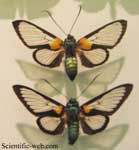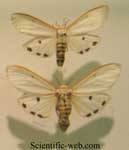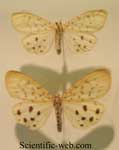


Arctiidae, Arctiidae , Arctiidae ,
Cladus: Eukaryota
Supergroup: Opisthokonta
Regnum: Animalia
Subregnum: Eumetazoa
Cladus: Bilateria
Cladus: Nephrozoa
Cladus: Protostomia
Cladus: Ecdysozoa
Phylum: Arthropoda
Subphylum: Hexapoda
Classis: Insecta
Subclassis: Pterygota
Divisio: Neoptera
Subdivisio: Endopterygota
Superordo: Panorpida
Ordo: Lepidoptera
Subordo: Glossata
Infraordo: Heteroneura
Divisio: Ditrysia
Sectio: Cossina
Subsection: Bombycina
Superfamilia: Noctuoidea
Name
Arctiidae Leach, 1815
References
* Pitkin, B. & P. Jenkins. Butterflies and Moths of the World: Generic Names and their Type-species. Natural History Museum.[1]
Vernacular names
Internationalization
English: Woolly Bears; Woolly Worms
Русский: Медведицы
See Arctiinae
Arctiidae is a large and diverse family of moths with around 11,000 species found all over the world, including 6,000 neotropical species.[1] This family includes the groups commonly known as tiger moths (or tigers), which usually have bright colours, footmen (which are usually much drabber), lichen moths and wasp moths. Many species have 'hairy' caterpillars which are popularly known as woolly bears or woolly worms. The scientific name refers to this (Gk. αρκτος = a bear). Caterpillars may also go by the name 'tussock moths' (more usually this refers to Lymantriidae, however).
Diagnosis
The most distinctive feature of the family is a tymbal organ on the metathorax.[1] This organ has membranes which are vibrated to produce ultrasonic sounds. They also have thoracic tympanal organs for hearing, a trait which has a fairly broad distribution in the Lepidoptera, but the location and structure is distinctive to the family. Other distinctive traits are particular setae ('hairs') on the larvae, wing venation, and a pair of glands near the ovipositor.[1] The sounds are used in mating [2] and for defense against predators.[3]
Aposematism
See also: Pyrrolizidine Alkaloid Sequestration
Many species retain distasteful or poisonous chemicals acquired from their host plants.[4] Some species also have the ability to make their own defenses (Nishida, 2002). Common defenses include: cardiac glycosides (or cardenolides), pyrrolizidine alkaloids, pyrazines and histamines.[4] Larvae usually acquire these chemicals, and may retain them in the adult stage. But adults can acquire them too, by regurgitating on decomposing plants containing the compounds, and sucking up the fluid.[4] Adults can transfer the defenses to their eggs, and males sometimes transfer them to females to help with defense of the eggs. Larval 'hairs' may be stinging, due to histamines the caterpillar makes, in some species but not all.
The insects advertise these defenses with aposematic bright coloration, unusual postures, odours, or, in adults, ultrasonic vibrations. Some mimic moths that are poisonous, or wasps that sting.[5] The ultrasound signals help nocturnal predators to learn to avoid the moths,[6][7] and can interfere with bats' ability to precisely locate flying moths (Ratcliffe and Fullard, 2005).
Behavior and life cycle
Many of the caterpillars and adults are active during the daytime. If disturbed, woolly bear caterpillars will roll into a tight spiral. Isabella tiger moths (Pyrrharctia isabella) overwinter in the caterpillar stage. They can survive freezing at moderate subzero temperatures by producing a cryo-protectant chemical.[8] The larvae of another species, Phragmatobia fuliginosa may be found on snow seeking a place to pupate.
Although abundant, few species in this family are of economic importance. Even the fall webworm, an abundant and highly polyphagous tree-feeding species that has spread from North America to Asia and Europe, does not do lasting damage to healthy hosts.
Folklore
Local folklore of the American Northeast holds that "woolly bears" have the ability to predict the weather, similar to that of the Groundhog. The forthcoming severity of a winter may be indicated by the amount of black on the Isabella tiger moth's caterpillar, the most familiar woolly bear in North America; more brown than black means a fair winter, but more black than brown means a harsh winter.[9] However, the relative width of the black band varies among instars, not according to weather.[10] The mythical qualities attributed to woolly bears in the American Northeast have led to such things as the Woollybear Festival.
Notable species
* banded tussock moth, Halysidota tesselaris
* banded woolly bear or Isabella tiger moth, Pyrrharctia isabella
* buff ermine, Spilarctia luteum
* cinnabar moth, Tyria jacobaeae
* common footman, Eilema lurideola
* dogbane tiger moth or Delicate Cycnia, Cycnia tenera
* fall webworm, Hyphantria cunea
* garden tiger moth, Arctia caja
* giant leopard moth, Hypercompe scribonia
* hickory tussock moth, Lophocampa caryae
* Jersey tiger moth, Euplagia quadripunctaria
* milkweed tussock moth, Euchaetes egle
* scarlet tiger moth, Callimorpha dominula
* Maltese ruby tiger moth, Phragmatobia fuliginosa ssp. melitensis
Notes and references
1. ^ a b c Scoble, MJ. (1995) The Lepidoptera: Form, Function and Diversity. Second ed. Oxford University Press.
2. ^ Simmons RB, Conner WE. (1996). "Ultrasonic signals in the defense and courtship of Euchaetes egle Drury and E. bolteri Stretch" (Lepidoptera: Arctiidae). Journal of Insect Behavior 9 (6): 909-919. DOI:10.1007/BF02208978
3. ^ Fullard JH, Simmons JA, Sailant PA (1994) Jamming bat echolocation: the dogbane tiger moth Cycnia tenera times its clicks to the terminal attack calls of the big brown bat Eptesicus fuscus. Journal of Experimental Biology 194:285–298
4. ^ a b c Weller SJ, Jacobsen NL, Conner WE (1999) The evolution of chemical defenses and mating systems in tiger moths (Lepidoptera: Arctiidae). Biol J Linn Soc 68:557–578.
5. ^ Simmons RB, Weller SE (2002) What kind of signals do mimetic tiger moths send? A phylogenetic test of wasp mimicry systems (Lepidoptera: Arctiidae: Euchromiini). Proc Roy Soc Lond B 269: 983–990
6. ^ Dunning DC, Roeder KD (1965) Moth sounds and the insect-catching behavior of bats. Science 147:173–174
7. ^ Hristov NI, Conner WE (2005) Sound strategy: acoustic aposematism in the bat–tiger moth arms race. Naturwissenschaften 92:164–169. DOI:10.1007/s00114-005-0611-7
8. ^ Layne JR, Kuharsky DK (2000) Triggering of cryoprotectant synthesis in the woolly bear caterpillar (Pyrrharctia isabella Lepidoptera : Arctiidae). J Exper Zool 286 (4): 367-371
9. ^ http://www.wunderground.com/blog/JeffMasters/comment.html?entrynum=226
10. ^ Wagner, DL, (2005) Caterpillars of Eastern North America. Princeton University Press.
Other references
* Bates DL, Fenton MB (1990) Aposematism or startle? Predators learn their responses to the defenses of prey. Can J Zool 68:49–52
* Dunning DC, Krüger M (1995) Aposematic sounds in African moths. Biotropica 27:227–231
* Dunning DC, Acharya L, Merriman CB, Ferro LD (1992) Interactions between bats and arctiid moths. Can J Zool 70:2218–2223
* Fullard JH, Fenton MB, Simmons JA (1979) Jamming bat echolocation: the clicks of arctiid moths. Can J Zool 57:647–649
* Science Fridays: Moths Can Escape Bats By Jamming Sonar
Further reading
* William Conner (ed.). (2009). Tiger moths and woolly bears : behavior, ecology, and evolution of the Arctiidae. Oxford University Press: New York. ISBN 9780195327373
Retrieved from "http://en.wikipedia.org/"
All text is available under the terms of the GNU Free Documentation License

